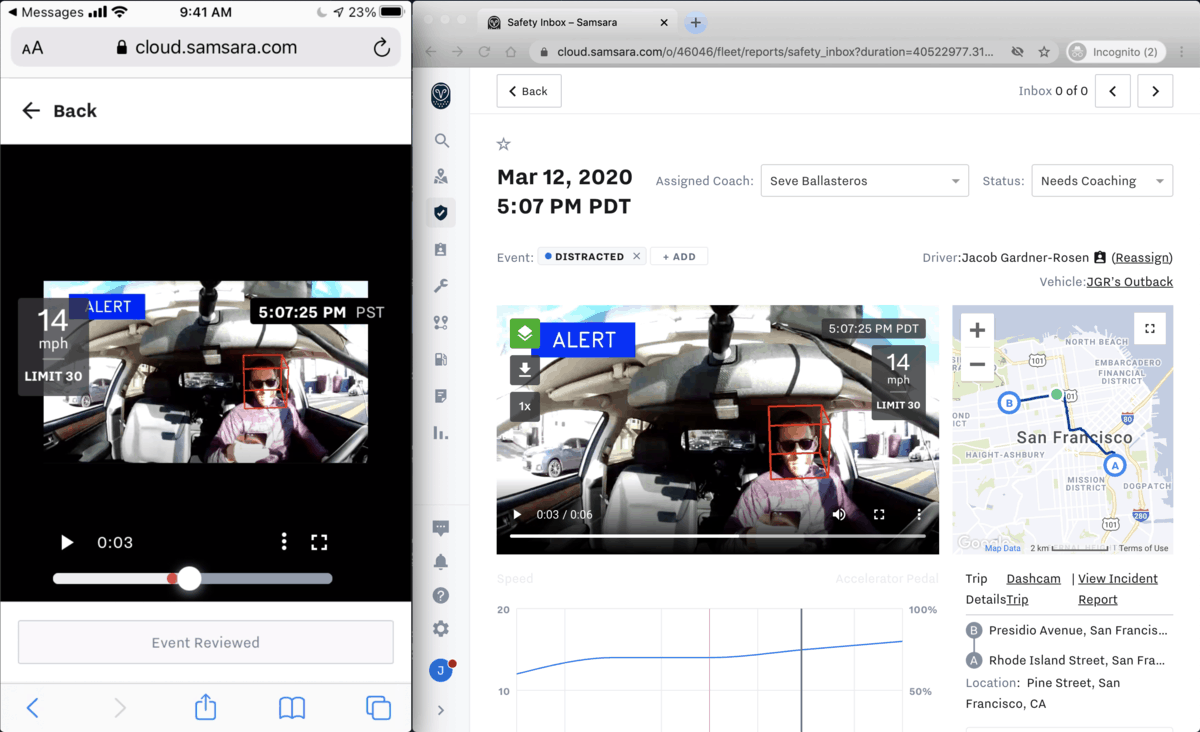Operating in a virtual world has been a struggle for some industries, including trucking, as companies work to comply with government regulations and their own internal policies, many of which are designed to minimize exposure to risk.
For fleets that require in-cab training or have specific policies in place that require monitoring, doing so virtually has been difficult at best — and impossible in the worst-case scenario.
Samsara has been busy developing new functionality for its AI dashcam product to address some of these new challenges. What the company has come up with are mask detection technology, live-streaming capabilities and Driver Video Share.
“We probably have dozens of features in development at any given time,” Ingo Wiegand, director of product management for Samsara, told FreightWaves. “These were features that were on our road map, but as we talked to customers and because of the pandemic, we wanted to get them out to the fleets as soon as we can.”
While most trucking companies likely don’t have specific policies on mask wearing inside the cab, many Samsara customers do. Ambulance and bus operations are among those that often require a driver wear a mask at all times. To address these concerns, the company has developed mask-detection technology.
“There is a whole range of use cases,” Wiegand said. “Some customers enforce two people in cab environments … and commercial drivers are considered essential workers during COVID and the CDC has guidelines [addressing mask wearing].”

Samsara’s new Driver Video Share functionality allows fleet managers to share specific videos and self-guided coaching via link. (Photo: Samsara)
The software update, which is free but must be turned on by customers, uses artificial intelligence and leverages existing Samsara dashcams to monitor for mask wearing. It can provide both in-cab alerts to the driver/passenger and can trigger dashboard event alerts with video for managers.
Driver video share is another new feature Samsara has added.
“Historically the safety manager would sit in person with the driver, go through our dashboards and go through a coaching session or maybe download a video and share it,” Wiegand said. “This allows a manager to share with the driver who can bring up the video link and review on their own time and on their own device.”
Samsara said this feature was added to address safety concerns for those fleets that are trying to minimize in-person meetings but still concerned about maintaining their safety program.
“This new feature is a targeted way for sharing individual videos with drivers,” Wiegand noted.
Drivers will receive a text message with a link to the video and event details, giving them a chance to engage in an evidence-based, self-guided coaching lesson. Following the pandemic, Driver Video Share should allow fleets to continue one-on-one coaching without the need to reroute drivers to a facility.
The final feature that may offer the most effective real-time coaching tool — but also may have the most controversy attached to it — is live streaming of video, both driver-facing and outward-facing.
For drivers concerned about “Big Brother” looking over their shoulders in real time, Wiegand stressed that the tool is a targeted application. The live-streaming functionality is off by default, so a fleet must physically turn it on, and that is one of the important characteristics of it from Samsara’s point of view. It also requires specific user roles and permissions to be set up before it is turned on.
“From a development perspective, driver trust and privacy is of the utmost importance. We set out to take a privacy-by-design approach,” Wiegand said. “[Fleets] should really tell the driver beforehand because as soon as the live stream is turned on, the driver is going to get an alert.”
Live streaming may not be for every fleet, or even every situation, but Wiegand believes it has a specific benefit during the COIVD pandemic.
“The most common use case for this is virtual ride-alongs,” he said. “Before the pandemic, if you had a new driver that needed to get onboarded to the fleet, you might have a [safety manager] ride along in the cab. COVID changed that.”
The live stream allows a manager to see exactly what a driver sees in real time, making the virtual ride-along possible.
All three features are now available. Each is set to off by default.
Click for more FreightWaves articles by Brian Straight.
You may also like:
Here’s where electric trucks make sense
Hino, Toyota bringing Class 8 fuel-cell truck to North America next year










